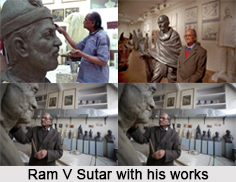 Ram Vanji Sutar is an Indian sculptor. Ram Vanji Sutar is the recipient of Padma Bhushan Awards, the third highest civilian award in 2016 and Padma Shri Awards, the fourth highest civilian award in year 1999 for his contribution in the field of art and sculpture.
Ram Vanji Sutar is an Indian sculptor. Ram Vanji Sutar is the recipient of Padma Bhushan Awards, the third highest civilian award in 2016 and Padma Shri Awards, the fourth highest civilian award in year 1999 for his contribution in the field of art and sculpture.
Early Life of Ram Vanji Sutar
Ram Vanji Sutar was born into a poor family, on 19th February in 1925, in the village of Gondur, in Dhulia district of Maharashtra.
Career of Ram Vanji Sutar
Ram Vanji Sutar took his lesson from Guruji Shri Shriram Krishna Joshi, who later encouraged him to join the Sir J.J. School of Art in Mumbai. By the end of his course there, in the year 1953 Ram Vanji Sutar topped the class and won the prestigious Mayo Gold medal for modelling. As a modeller for the Department of Archaeology, South Western Circle, Aurangabad, between 1954 and 1958 he was involved in restoring several ancient sculptures found in the caves of Ellora and Ajanta. In 1958-59, he was Technical Assistant in the Exhibition Division of Audiovisual Publicity, Ministry of I & B, New Delhi, for preparing various types of models on the Five Year Plans. He left his Government job in 1959 with the intention of becoming a professional sculptor.
Works of Ram Vanji Sutar
The first work of Ram Vanji Sutar was the 45 feet Chambal monument at the Gandhi Sagar Dam, in Madhya Pradesh. This 45 feet high gigantic masterpiece carved out of a single block depicts mother Chambal with her two children- Madhya Pradesh and Rajasthan symbolizing the brotherhood of the two states. Jawaharlal Nehru the Prime Minister was so impressed with this magnificent work that he asked Ram to do a similar 50 feet high monument in bronze for the Bhakra Dam to commemorate the workers who laid down their lives during the making of this stupendous engineering marvel of modern India. But this work modelled on the theme of Triumph of Labour was left incomplete due to paucity of funds. The most well known among his works is the bust of Mahatma Gandhi that he sculpted, which is instantly recognizable worldwide, and copies of it were presented by the Government of India to other countries like France, Italy, Argentina, Barbados, Russia, England, Italy, and Argentina where they have been put on display on the occasion of the Gandhian Centenary Celebrations. However the largest copy of this bust was made for the International Trade Fair of Asia in `72 & is permanently on display at Pragati Maidan in Mathura Road. Mahatma Gandhi has always been his most frequent muse. He has also sculpted Mahatma Gandhi statues in meditation pose, 17 feet high, which is installed at Gandhinagar, Gujarat and at Parliament House, New Delhi. A 13 feet high monumental statue of Mahatma Gandhi accompanied by Harijan children was sculpted for Sandur in Bengaluru, Gandhi Smriti in Delhi and Delhi Public School in Noida. There is another well known sculpture of his, the 21 feet high Equestrian statue of Maharaja Ranjit Singh which he made for Amritsar. Other notable sculptures are the 10 feet high bronze statue of Govind Ballabh Pant overlooking Rafi Marg in New Delhi and the depiction of Goddess Ganga and Yamuna at the Rose Garden, in Ludhiana, in Punjab. Ram V Sutar is a part of world famous Statue of Unity project of the India. He is the main designer of this unique project and the main contractor is L & T.
Awards Received by Ram Vanji Sutar
In 1999, Ram Vanji Sutar received the Padma Shri Award from Government of India. In the year 2016, Ram Vanji Sutar received Padma Bhushan award from the Government of India. He has created more than fifty monumental sculptures in the last forty years of his career. Anil Sutar, his architect-sculptor son, conceived and landscaped a sprawling sculpture garden, called Anand Van, beside the Surajkund-Batkal lake road, where gigantic white fibreglass replicas of Mr. Ram Sutar`s creations have been put up on display. He and his son presently have a company studio of their own in Noida.
Personal Life of Ram Vanji Sutar
In 1952 Ram Vanji Sutar got married to Pramila and like him their only son Anil Sutar (born in 1957) is also a sculptor.



















